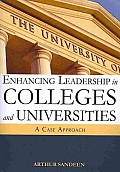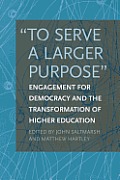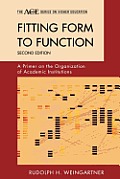Enhancing Leadership in Colleges and Universities: A Case Approach. Arthur Sandeen. Springfield, IL: Charles C. Thomas, 2011.
“To Serve a Larger Purpose”: Engagement for Democracy and the Transformation of Higher Education. John Saltmarsh and Matthew Hartley, eds. Philadelphia: Temple University Press, 2011.
Fitting Form to Function: A Primer on the Organization of Academic Institutions. Rudolph H. Weingartner. 2nd ed. Lanham, MD: American Council on Education and Rowman and Littlefield, 2011.
Higher education leadership is facing different versions of some of the same challenges that the faculty is facing: managing with restricted resources from state and federal funding as well as from tuition dollars; demonstrating to a skeptical public that what we are doing in higher education is worth investing in; and balancing the different sides of an institution’s structure, personality, and business, from academics to athletics to student affairs. This collection of volumes, aimed primarily at campus administrators, raises these issues and more. Some of the writers understand better than others the interdependencies of faculty, administrators, campus staff, and (even) students. I write this review as I pack up my own books in my faculty office before moving to another campus as a dean, so the question for me is, which of these volumes will I want to keep at hand as I learn to work in a new leadership context?
Let’s start with that notion of higher education leadership itself. Campuses are led by a number of different people with different stakes in the institution. In most writing on higher education, as in Arthur Sandeen’s Enhancing Leadership in Colleges and Universities, “leaders” are administrators. Sandeen presents fictional case studies involving fundraising, financial aid, construction of athletic facilities, student alcohol abuse, career services, and other issues. All the cases are realistic, and the many options suggested for discussion of these scenarios (an increasingly ineffective dean of students, alcohol-related student deaths, rethinking merit-based state aid, and so on) will make for lively discussion in any group that chooses to use them for leadership training.
What was consistently missing from the cases and their suggested solutions, however, was any consideration of the use of shared governance structures; it was as if problems at colleges and universities were entirely in the hands of provosts, presidents, and deans. In the five case studies in the student affairs section of the book, for example, only one option (of the twenty offered in total) proposed using an existing institutional governance structure (a faculty council), and one other option suggested the creation of an ad hoc faculty-staff committee. Administrators alone made the decisions in all the other cases, in eighteen suggested scenarios. Even the section of the book devoted to case studies in academic affairs, including curriculum revision and the addition of new degree programs, paid little attention to the faculty as a resource for administrators, let alone as a partner in decision making. Administrators in the case studies tend to assemble task forces of their own choosing when seeking advice, even those fictional administrators who are most sympathetic to faculty governance.
Thinking about the case studies in Enhancing Leadership reminded me of the importance of starting with shared governance structures when we are confronted with problems or quandaries on our campuses. Leadership training in higher education often encourages us to consult other leaders and to think about all our constituencies in our decision making, but such training rarely foregrounds existing committee structures or the importance of elected faculty and staff committees.
Concern with democratic governance is at the heart of “To Serve a Larger Purpose,” but it’s not campus democracy—it’s the democratic purpose of higher education, what Ernest Boyer called its “civic mandate.” That’s the framework for John Saltmarsh and Matthew Hartley’s collection of articles about civic engagement work in higher education. Saltmarsh, who directs the New England Regional Center for Higher Education at the University of Massachusetts Boston, and Hartley, chair of the higher education department in the Graduate School of Education at the University of Pennsylvania—both national figures in the world of civic engagement—pronounce the current state of that field to be one of “fragmentation and drift.” They argue that “the dominant paradigm of civic engagement in higher education does not express or seek to fulfill a democratic purpose,” and they indicate that they are aiming to change that, working toward “the reclamation of the democratic purposes of civic engagement and an examination of the requisite transformation of higher education that would be required to achieve it.” The editors see themselves as part of a movement to shift civic engagement work on campuses away from a vague focus on voluntarism and service-learning courses (at best a third of courses even at the most civically engaged campuses) and toward “an agenda that seeks significant societal change,” to “assume a joint responsibility with the communities with which [the college or university] works to confront problems and to enact change through every democratic means possible.” This focus on change as a goal in and of itself makes me a bit nervous, but they go on to specify that their new movement “requires linking the pursuit of knowledge with the pursuit of a healthier society and a stronger, more robust democracy.”
I’ve been looking for the best place to focus my own interest in strengthening the social contract between higher education and the rest of society, the sense of mutual obligation that used to mean, as Neil Hamilton has pointed out in Academe, that the nation put its faith in colleges and universities to pursue research and educate the nation’s youth and trusted that higher education institutions would act with the best interests, the long-term interests, of society in mind. But I have not been convinced that the civic engagement movement in higher education was the way to strengthen that contract. My impression, confirmed by this volume’s description of the problems with the movement, was that civic engagement in the college setting consisted of a combination of service-learning initiatives from individual faculty members and student voluntarism channeled through campus community-involvement offices. All good stuff, of course, but I’m interested in the way institutions as a whole understand their obligations to their communities and to society—the way a college sees itself as contributing to its town, city, or state, as well as the way it sees itself contributing to the greater good of society. The other side of the contract is, according to Hamilton, that society values higher education and allows it to regulate itself, just as the legal and medical professions do.
Especially since the economic crisis that started in 2008, however, society has increasingly challenged higher education’s self-regulation, and civic engagement initiatives are not answering the challenge. The articles in the Saltmarsh and Hartley collection grew out of a 2008 Kettering Foundation–sponsored gathering of higher education leaders (defined, in this case, as faculty members active in community engagement, international studies, or higher education departments, along with some deans and vice presidents and representatives of such groups as Campus Compact, Imagining America, and the Association of American Colleges and Universities) who agreed that the civic education movement had not been as successful as was intended and asserted that higher education must play a role in meeting the “significant societal challenges” facing the nation.
Part of the problem the Kettering attendees identified was that the academy sees itself as a producer of specialist knowledge, with “narrow disciplinary guilds.” A new “democratic epistemology” is called for if institutions are to play a role in promoting a strong democracy, producing knowledge “with the active participation of citizens,” and modeling democracy in campus governance, including challenging president-centered leadership. The most difficult aspects of this volume’s approach to the civic engagement issue are these larger questions. The book refuses to countenance a “place-based learning” approach to civic engagement and instead focuses on “purpose and processes” that move campuses beyond engagement with particular initiatives in their community backyards and compel them to look at their own policies and practices in relation to a democratic ideal. The result is “democratic engagement” in campus governance as well as in the work of faculty and staff in student development. Stay away, Saltmarsh and Hartley caution, from community engagement for its own sake—that ends up being a public-relations exercise. Instead, rethink engagement entirely, focusing on the role our institutions play in community, civic, and political life and the role democracy can or should play in campus life.
The essays in the volume address particular aspects of the question in relation to particular initiatives, such as Campus Compact, university-assisted community schools, or student-led campus-city engagement projects. But the collection is far from a best-practices volume. Every essay refuses the one-step answers that may have characterized past civic engagement efforts—all the volume’s authors examine critically what has gotten the movement to this point, and all offer careful consideration of what will be necessary if civic engagement is to become a truly democratizing, diversifying force that knits higher education into the social fabric.
From a critical examination of an important movement in higher education, I turn to a critical examination of institutional structure in higher education. And I ask myself, how have I worked in higher education so long without having read Rudolph H. Weingartner’s Fitting Form to Function: A Primer on the Organization of Academic Institutions before? This slim paperback, originally published by the American Council on Education in 1996, appeared in a second edition in 2011 with revisions that take account of the increasing reliance on contingent faculty and the increasing role of the university general counsel as well as new material on educational technology and community colleges.
Weingartner, professor emeritus of philosophy at the University of Pittsburgh, served as dean of arts and sciences at Northwestern University and provost at Pitt, and his lively, insightful, and often funny descriptions of the various aspects of college and university structure are going to be something I return to again and again. The book’s title and a table of contents that lists chapters on the office of the president, the central administration and the faculty, the office of the dean, the office of the provost, and other administrative offices might lead you to believe that the volume is a summary of the activity that goes on in each section of the campus—and that would be a valuable thing in and of itself. Each chapter does describe the functions of the office it introduces, to be sure, but the value of this volume is its careful, ethical work, in each chapter, on the core topic of decision making. Weingartner is committed to helping his readers, from the faculty and administrative ranks, understand the implications of various campus structures for the decisions that are made on campus. His philosopher’s approach means that he takes us very carefully through the ramifications of reporting structures: if the athletic director reports to the dean of students, that assumes (and ensures) one kind of role for athletics on a campus; if the AD reports to the vice president for business and finance, a different kind of accountability is in order; and still another set of assumptions about autonomy and external relations operates if the AD reports directly to the president.
Weingartner’s twenty-seven guiding maxims run the gamut from statements that seem obvious, although they may not always happen in practice (Maxim 4: “Supervising is work, calling for the dedication of time, energy, and know-how”), to ones that take a little more thought (Maxim 10: “The whole is both greater and less than the sum of its parts: neither an institution’s budget, plan, nor aspirations can be constructed out of those of its constituent parts”). The maxims stand alone at the beginning of the volume, but they’re also illustrated organically throughout the chapters of the book.
The book’s weakness is similar to the weakness of the other volumes, though, in that it doesn’t consider faculty as an asset—or much at all, actually. Nor does it give much attention to the differences between types of higher education institutions. Decision-making structures are the key to understanding how institutions function, to be sure, but community colleges, research universities, and small religious colleges, for example, must start from different assumptions.
This volume’s attention to decision-making structures directs us to consider the implications for institutional governance of every aspect of campus administration. Weingartner is ruthless on the topic of meaningless consulting mechanisms and administrative micromanagement, and he is equally hard on faculty senates that do not engage a wide spectrum of their faculty but instead rely on career campus politicians. He gives thoughtful consideration to the effect on campus governance of every aspect of campus structure, focusing on what he defines as the three types of campus decisions: the Consultative Decision, in which the faculty has the least power to determine an outcome; the Codeterminative Decision, in which the faculty gives both advice and consent; and the All-But- Determinative Decision, in which faculty members make decisions that administrators may overrule only in extreme cases and for explicitly stated strong reasons. Which structure is in use on your campus for which issue?
Every faculty member who wants to understand how decisions are made on campus should invest in this volume. I will be ordering copies for my campus AAUP chapter as a parting gift from a past president. And I will be keeping this one myself, to refer to often as I learn the structures of my own new campus.
Paula M. Krebs, a professor of English at Wheaton College (MA) for many years and a former faculty editor of Academe, is now dean of humanities and social sciences at Bridgewater State University. Her e-mail address is [email protected].






